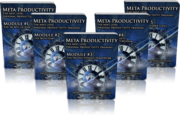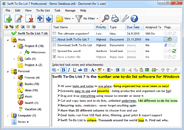Since publishing the first summary of the best posts, many new posts were written on this blog. It’s time for another recap baby!
The posts published since the last summary can be divided into three main categories:
- Productivity posts: How to do more in less time and be happier
- Swift To-Do List related posts: Tips, tricks, news, highlights.
- Getting Things Done posts – GTD tutorial by our guest writer Brian
So, without further ado, here goes. Enjoy!
Productivity posts:
- 10 best tricks of fooling myself to work – this post went viral: over 100.000 readers!
- Creating Lasting Happiness In 5 Minutes a Day – super-powerful yet simple journaling technique
- The Now Habit Summary – detailed summary of the best book on procrastination
- Accidental Genius Summary – detailed summary of the best book on creative thinking and writing
- The next actions and prioritizing – how to keep track of what to do next
- Achieving Goals Like a Mad Klingon – do you want to attain your goal badly?
- 10 quick fixes of motivation – feeling down and unproductive? This should get you going again.
- Why plants on workdesks boost creativity by 15%
Swift To-Do List related:
- Turn emails into tasks – just drag & drop them into Swift To-Do List! – the greatest new feature?
- Synchronize Swift To-Do List with Dropbox
- What’s New in 7.33 – learn about recurrence after completion, recurrence preview, and how to permanently delete to-do lists
- What’s New in 7.307 – learn about tree export to HTML
- What’s New in 7.30 – learn about in-place editing.
- What’s New in 7.26 – learn about time-tracking
- What’s New in 7.25 – learn about the Import Wizard and the improved Batch Edit
- We’ve just sent the first $50 donation to WWF! – you help us to help charities!
GTD posts:
- Getting Things Done (GTD) Tutorial: Basics – what’s GTD all about?
- Getting Things Done (GTD) Tutorial: Do I Need to GTD?
- Getting Things Done (GTD) Tutorial: Perspective
- Getting In The Ready State (To Get Things Done)
- Getting Things Done (GTD) Tutorial: Commitment Management – manage what’s on your plate
- Managing Actions Horizontally and Vertically
What I think
I’m really happy about the direction this blog is taking. While I am usually fully focused on development, you bet I will keep bringing you new intriguing posts in the future.
The exceptional success of the “10 best tricks of fooling myself to work” post has really humbled me as a writer (and marketer). It was the most successful piece I’ve ever written – just the thousands of shares on social media are truly mind-blowing to me. That being said, I am still better software designer than blogger and writer. But I will keep working at it ;-)
And hey, check out also the previous “Best Of This Blog (Part 1)“





